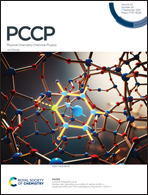Investigation of the complex vibronic structure in the first excited and ionic ground states of 3-chloropyridine by means of REMPI and MATI spectroscopy and Franck–Condon analysis
Abstract
3-Chloropyridine (3-CP) has been investigated by means of resonance-enhanced multi-photon ionization (REMPI) and mass-analyzed threshold ionization (MATI) spectroscopy to elucidate the effect of m-chlorine substitution on the vibronic structure of the first electronically excited and ionic ground states. The S1 excitation energy has been determined to be 34 840 ± 2 cm−1 (4.3196 ± 0.0002 eV) with a difference of less than 0.2 cm−1 between both isotopomers, which is the first reported value for this transition in the gas phase so far. The S1 state has been assigned to the 1π* ← n transition. It is subject to strong vibronic coupling via ν16b to one or both of the lowest 1ππ* states. In addition, strong coupling via at least one more non-totally symmetric vibration is very likely to exist but the vibration could not be identified yet. Overall, the coupling results in a minimum S1 structure with C1 symmetry. The adiabatic ionization energy of the nN-LP orbital (14a′) has been determined to be 75 879 ± 6 cm−1 (9.4078 ± 0.0007 eV) with a difference of less than 2 cm−1 between the two isotopomers, which is the first value reported for this state so far. The ionic ground state exhibits a distinct vibronic coupling via ν16a and ν10a to either the D1 state (4a′′) and/or D2 state (3a′′), which results in a twisted D0 geometry with C1 symmetry. As a consequence of the warped geometry in both S1 and D0 states, very complicated MATI spectra were obtained when exciting S1 states at higher wavenumbers.



 Please wait while we load your content...
Please wait while we load your content...